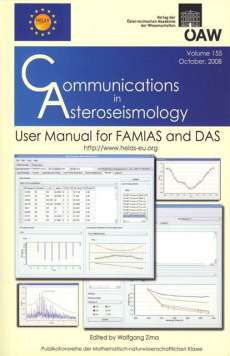Wolfgang Zima / Michel Breger
Communications in Asteroseismology Vol. 155, 2008
User Manual for FAMIAS and DAS
Reihe: Communications in Asteroseismologyie Serie Communications in Asteroseismology (CoAst) stellt eine international gefragte Plattform für wissenschaftliche Publikationen der neuesten Forschungsergebnisse auf dem Gebiet der Asteroseismologie dar. Forschungsgegenstand der Asteroseismologie sind pulsierende Sterne. Neben den halbjährlich erscheinenden regulären Ausgaben mit Beiträgen aus der laufenden Forschung werden auch Sonderausgaben für Konferenzberichte bzw. Programmhandbücher herausgegeben. Das Volume 155 enthält Benutzerhandbücher zweier Softwarewerkzeuge, die der Asteroseismologie gewidmet sind. Es handelt sich dabei um das Webinterface DAS (Database AsteroSeismology) und das Softwaretool FAMIAS (Frequency Analysis and Mode Identification for Asteroseismology). Beide Werkzeuge wurden im Rahmen des von der Europäischen Union gegründeten und finanzierten europäischen Netzwerkes für Helio- und Asteroseismologie (HELAS) mit dem Ziel erstellt, einen benutzerfreundlichen Zugang internationaler Forschungseinrichtungen zu state-of-the-art Methoden der Asteroseismologie zu ermöglichen. Erfolgreiche Asteroseismologie von Sternen auf der Hauptreihe hängt in großem Maße davon ab, dass die Oberflächenstruktur der Pulsationsmoden durch Modenidentifikation bekannt ist. Letztere kann durch Modellierung der Helligkeitsvariationen des Sterns in verschiedenen photometrischen Filtern und der Intensitätsvariationen im Profil von Absorptionsspektrallinien ermittelt werden. Das FAMIAS-Programmpaket bietet als Analysewerkzeug spektroskopischer und photometrischer Zeitseriendaten Werkzeuge, um Pulsationsmoden zu finden und eine Modenidentifikation durchzuführen und so die Pulsationsquantenzahlen, den Grad l und die azimuthale Ordung m zu bestimmen. Die Datenbank DAS enthält eine gut dokumentierte Bibliothek von Lichtkurven und Zeitserienspektren von ausgewählten pulsierenden Sternen. Sie bietet zusammen mit FAMIAS ein komplettes Werkzeugpaket für die Modenidentifikation für Forscher und Studenten, die auf dem Gebiet der Asteroseismologie arbeiten. Mit dieser Sonderausgabe von Communication in Asteroseismology wird das Benutzerhandbuch veröffentlicht. Die gedruckte Version des Benutzerhandbuchs wurde mit EU-Mitteln unterstützt.
…
The publication series of Communications in Asteroseismology (CoAst) is one of the most important international journals in the field of asteroseismology. Asteroseismology is the science concerned with stellar pulsation. Every six months, CoAst publishes a newsletter with papers about the latest results and ongoing research projects. Besides these regular issues, special issues such as conference proceedings or software manuals are published in this series. CoAst volume 155 contains two manuals of software tools dedicated to asteroseismology: the web interface DAS (Database AsteroSeismology) and the software package FAMIAS (Frequency Analysis and Mode Identification for Asteroseismology). Both tools have been developed in the framework of European Helio- and Asteroseismology Network (HELAS), which was founded and is funded by the EU. The aim of the FAMIAS / DAS packages is to enable user-friendly access to state of the art methods for asteroseismology. Successful asteroseismology of stars on the main sequence hotter than the sun is highly dependent on the knowledge of the surface structure of pulsational modes, by means of mode identification. Mode identification can be derived from modeling the luminosity variations of the star in several photometric filters and intensity variations in the profile of absorption lines. FAMIAS is a sophisticated tool for the analysis of spectroscopic and photometric time series to find pulsational modes and the corresponding pulsational quantum numbers: the degree l and the azimutal order m. The database DAS contains a well documented library of light curves and spectroscopic time series data of selected pulsating stars. Together with FAMIAS, it provides a complete package of tools for mode identification to researchers as well as to students, working on the field of asteroseismology. This volume is the printed version of the two manuals and is funded by the EU.
